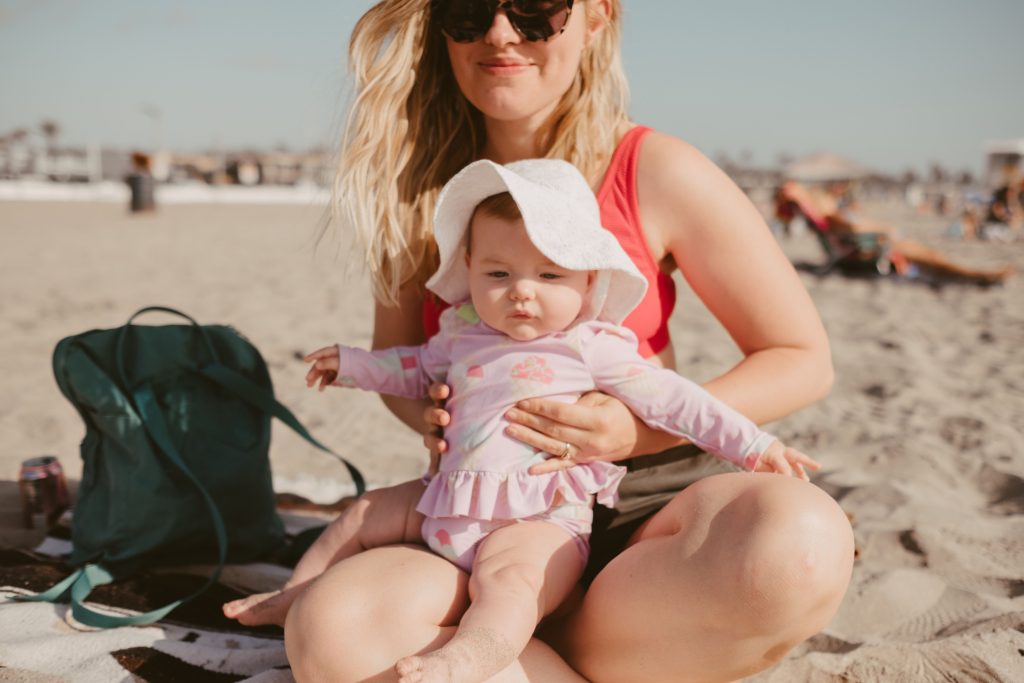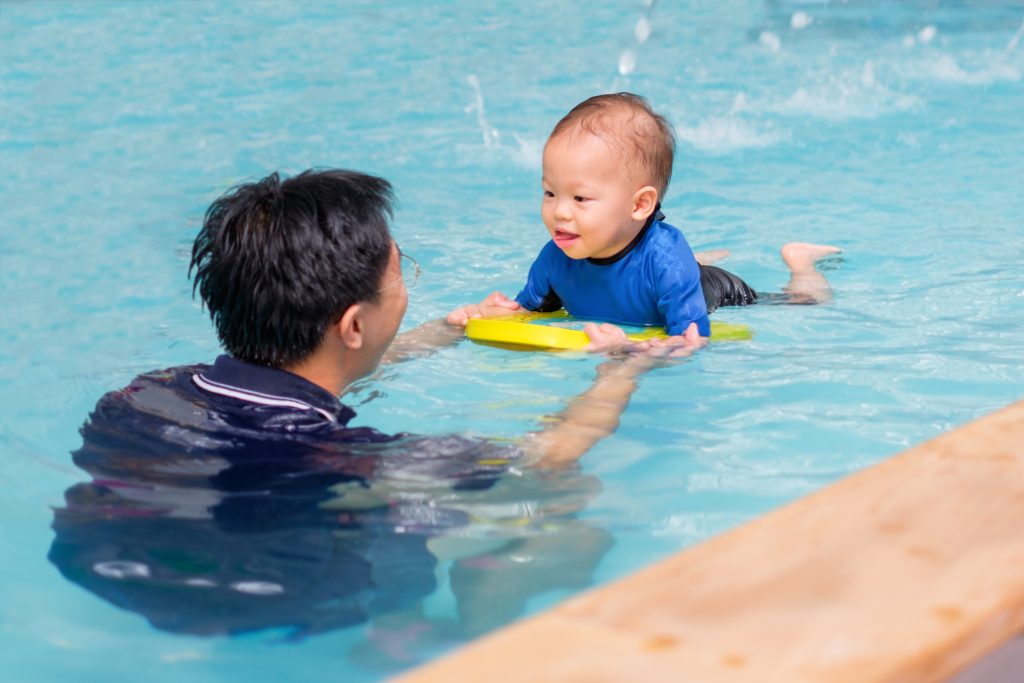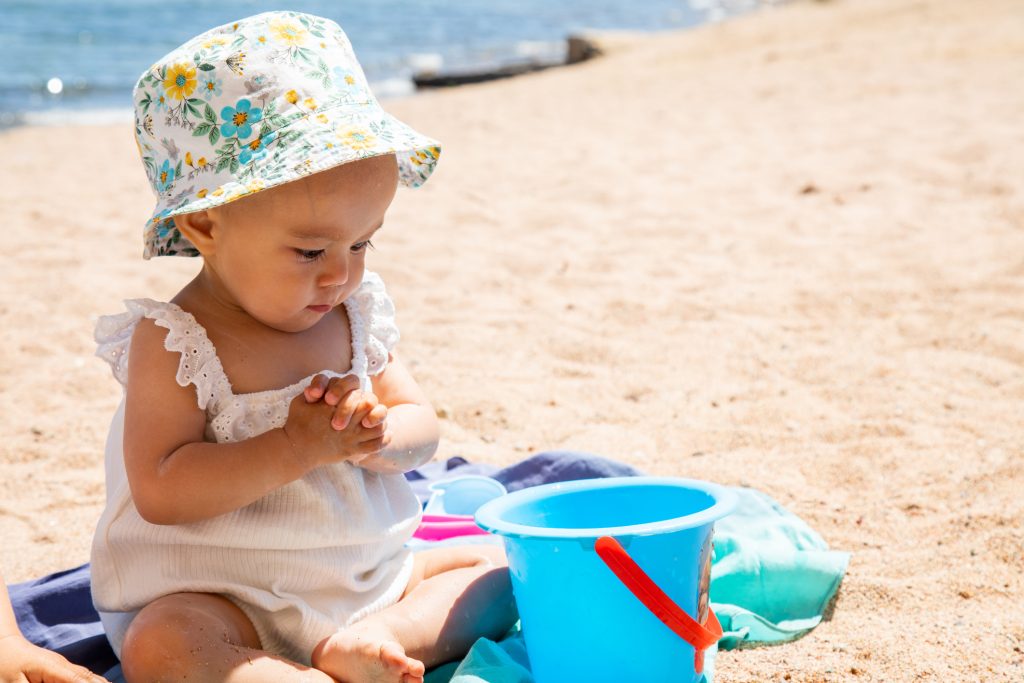This blog was updated on 4/17/2024.
When summer heats up, so does the sun! That means we have to be even more careful about baby sun protection during these hot and sunny summer months.
This blog provides tips for infants in the sun, including when and how to use sunscreen and protective clothing and what to do if your baby gets sunburned. Keep reading for sun safety for babies and your family!

Ensure your child’s health with a caring and experienced physician – find a provider today.
Understanding baby skin
Once your baby arrives there are so many new things to learn to keep your bundle of joy happy and healthy. Learning how to care for your child’s skin is especially important now that summer weather is starting up.
The American Academy of Pediatrics (AAP) says that a baby’s skin is thinner and more delicate than an adult’s. This means that babies are more likely to get burns and irritations. This is why we recommend using gentle cleansers and lotions with minimal fragrances as you care for your baby’s skin. This is also important when using sunscreen, as we’ll explore later in the article.
Sun safety tips
Being outside on a hot day can be intense for babies in the sun. A comprehensive protection plan for baby in the sun will give your family peace of mind so everyone can have fun and stay safe together.
To keep your baby protected from the sun’s harsh effects, follow these essential safety tips for babies and the sun from the AAP.
- Stay in the shade: Keep your baby sheltered from direct sunlight, stay in the shade under an umbrella or canopy. This is especially important for newborns.
- Wear protective clothing: Dress your baby in light, protective clothing that covers their body, like lightweight pants, long-sleeved shirts and hats.
- Limit sun exposure: Avoid staying in the sun for too long with your baby or infant. Again, limiting newborn sun exposure will help avoid sunburn and overheating.
- Wear sunglasses: Protect your baby’s eyes with sunglasses that have at least 99% UV protection.
- Use sunscreen sparingly: Parents and caretakers should apply sunscreen sparingly to babies under 6 months of age. Babies that young should wear protective clothing instead of using sunscreen all over.
When can babies wear sunscreen?
As a parent, you might be wondering about the guidance for sunscreen on babies. Knowing the right way to handle sunscreen for babies under 12 months doesn’t have to be complicated.
Babies can wear sunscreen, but depending on their age you should follow AAP guidelines.
For babies younger than 6 months, the AAP sunscreen recommendations say that you should only use small amounts of sunscreen. Use sunscreen for infants sparingly on places like their face but it is more important to dress them in protective clothing and keep them shaded and out of the sun.
For babies older than 6 months, apply sunscreen to all areas of the body. Be mindful to keep sunscreen away from their eyes and note any rashes or irritation that occurs in case you need to try a different brand with titanium dioxide or zinc oxide.

Learn safety tips and best practices to get comfortable babywearing your little one.
Sun protection for babies under 6 months
For newborn sun protection, it will be best to keep your baby out of the sun and heat when the UV rays are the strongest – usually between 10 a.m. and 4 p.m. – to avoid overheating or burning.
Many people also wonder if they can use sunscreen for babies under 6 months. Because of their sensitive skin, young babies are prone to rashes and other side effects. Instead, prioritize shade and minimize direct sunlight if possible. If being in the sun is unavoidable, then use sunscreen.
You can use sunscreen on small areas of the body, such as the face, ears, neck, etc. if shade or protective clothing is unavailable. Always avoid sunscreen around the eyes and pay special attention when using sunscreen on areas that young kids might suck on like hands and feet.
Sun protection for babies over 6 months
For babies older than 6 months, experts recommend applying sunscreen to all areas of their bodies. Here are some additional sunscreen for infants tips:
- Apply sunscreen early: Don’t wait until you’re outside to put on sunscreen. It needs 20-30 minutes to absorb into your skin, so apply it before you and your family head outside.
- Amounts: Sunblock, like zinc oxide, is a physical barrier that starts protecting the skin immediately. Anticipate using several ounces for every application.
- Reapply: Reapply sunscreen every two hours. Also, make sure to reapply after swimming, sweating or drying off with a towel.
- Apply to lips: Apply protection to the lips as well, with a lip balm with SPF 15 or higher.
How to choose the right sunscreen
With all the sunscreens available these days, choosing the right one for your kids can be tricky. But what matters most when using sunscreen is how well it protects the skin from UV rays. Making sure you are thinking about factors like SPF, lotion vs. spray and more can help.
- SPF: For kids, there is no reason to be using an SPF that is less than 30.
- Sunscreen lotion: Sunscreen lotion (rather than spray) is your best bet for full protection because you can actually see where you’re applying it.
- Sunscreen spray: It is difficult to determine where the spray has and has not been applied. Plus, it’s uneven and the layer of protection is thin.
- Choose broad spectrum: Broad-spectrum sunscreen protects against both UVA and UVB rays.

Learn more about the 4th trimester and early child development to support your baby’s growth.
Treating sunburns on babies
The sun can cause sunburn within 15 minutes, but you may not notice the redness and discomfort for a few hours. Repeated sunburns can lead to skin cancer. Unprotected sun exposure is even more dangerous for kids who have moles or freckles, very fair skin, and hair, or a family history of skin cancer.
If your baby or child gets sunburned, you need to take these steps to help treat the burn. Here are some ways to help soothe the pain at home.
- Stay hydrated: Make sure your child stays hydrated, give them extra liquids for the next 2-3 days.
- Cool down with damp cloths or showers: Have your child take a cool (not cold) shower or bath, or apply cool compresses as often as needed.
- Pain relief medicine: Give your child ibuprofen or acetaminophen as directed, if needed, to relieve pain.
- Topical lotions and gels: Use moisturizing creams or aloe gel to provide comfort.
- Stay out of the sun: Once sunburned, get out of the sun right away. And, when you go outside, make sure to fully cover all sunburned areas to protect the skin from the sun until they heal.
- Sunscreen on sunburn: If sunburned, you can apply some sunscreen to prevent it from getting worse. Be careful and follow the same rules for sunscreen application based on your baby’s age. If burned, sunscreen can irritate skin more or sting so avoid further sun exposure if possible.
When to contact a doctor
If your baby is younger than one year old and gets sunburn, we recommend calling your baby’s doctor. This will ensure you know how to care for the skin and help it heal. Here are additional reasons you may want to get medical care:
- A sunburn causes blisters or is extremely painful.
- Your child has facial swelling from a sunburn.
- A sunburn covers a large area.
- Your child develops a fever or chills after getting sunburned.
- Your child has a headache, confusion, or a feeling of faintness.
- You see signs of dehydration (increased thirst, less pee, or dry eyes and mouth).
The Mother Baby Center: holistic care from pregnancy to postpartum
It’s important to prioritize your baby’s sun safety this summer. Follow these tips for babies and kids in the sun, including when and how to use sunscreen, and protective clothing, and what to do if your baby gets sunburned.
If you are looking for additional information to support your child’s development and growth, explore our blog! Plus, if you’re looking to find a place to deliver, take a tour of any of the locations including Minneapolis, St. Paul and Coon Rapids.